Virtual Field Trip
from virtual-geology.info

Locality 3.1 - Caswell Bay
It is important that you access
this field trip on a laptop or desktop PC. Click on any image to enlarge
it.
Where are we? Today we've
driven east to the South Glamorgan coast, on the beautiful Gower Peninsula near
Swansea. Study the area in Google
Maps and Streetview.
At this location, our logged section
takes us through several major units of the Pembroke Limestone Group (Lower
Carboniferous), in stratigraphic order from the base.
Handout: refer to the handout
for today, which contains essential diagrams and information. Don't forget to
use the information in the Field Guide too. Both are available in Course Resources.
Tasks: See today's handout.
Record all your observations in your virtual notebook.
|
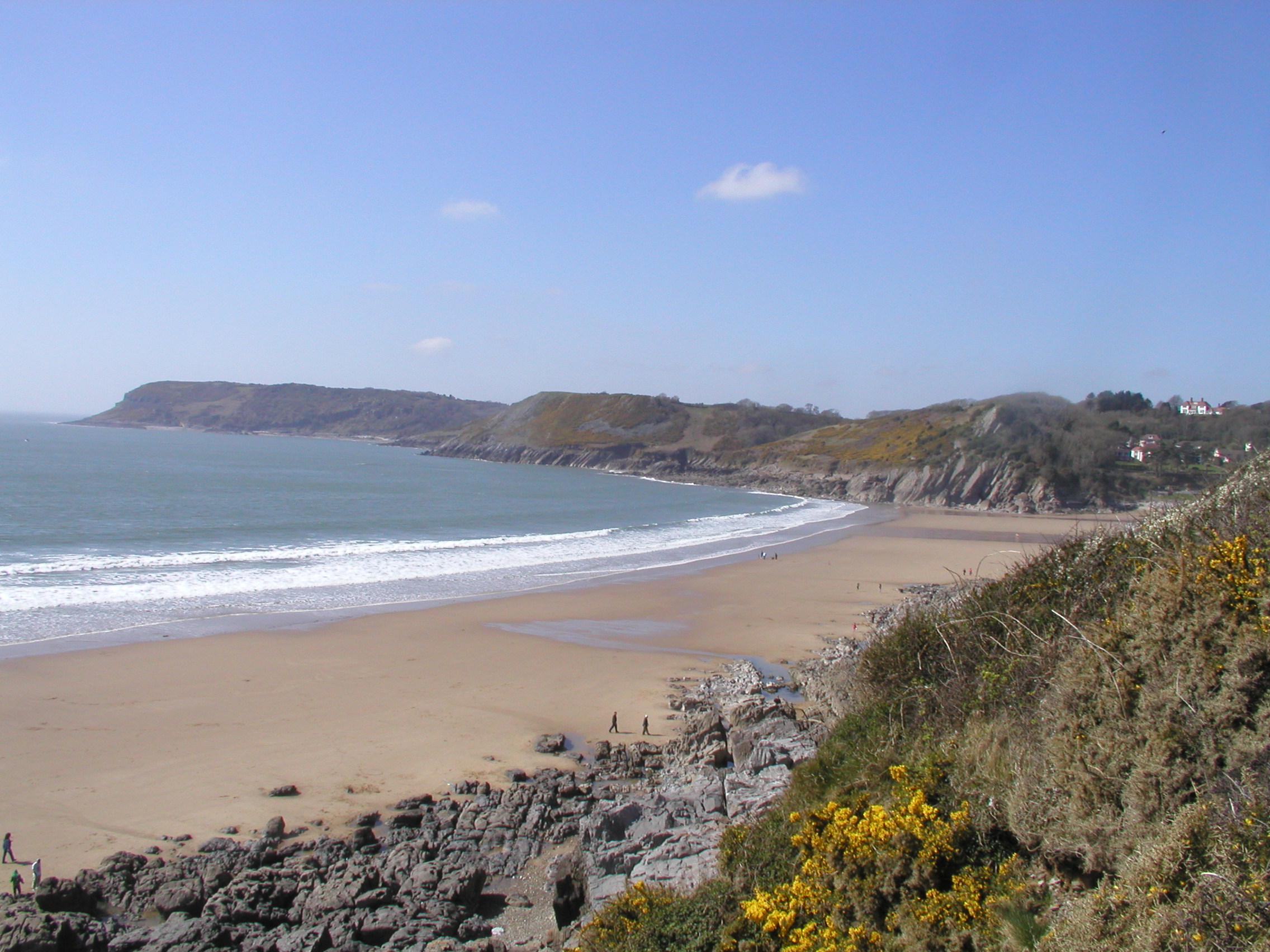
A. General view of the logged section (foreground) on the east side of
Caswell Bay
Question
|
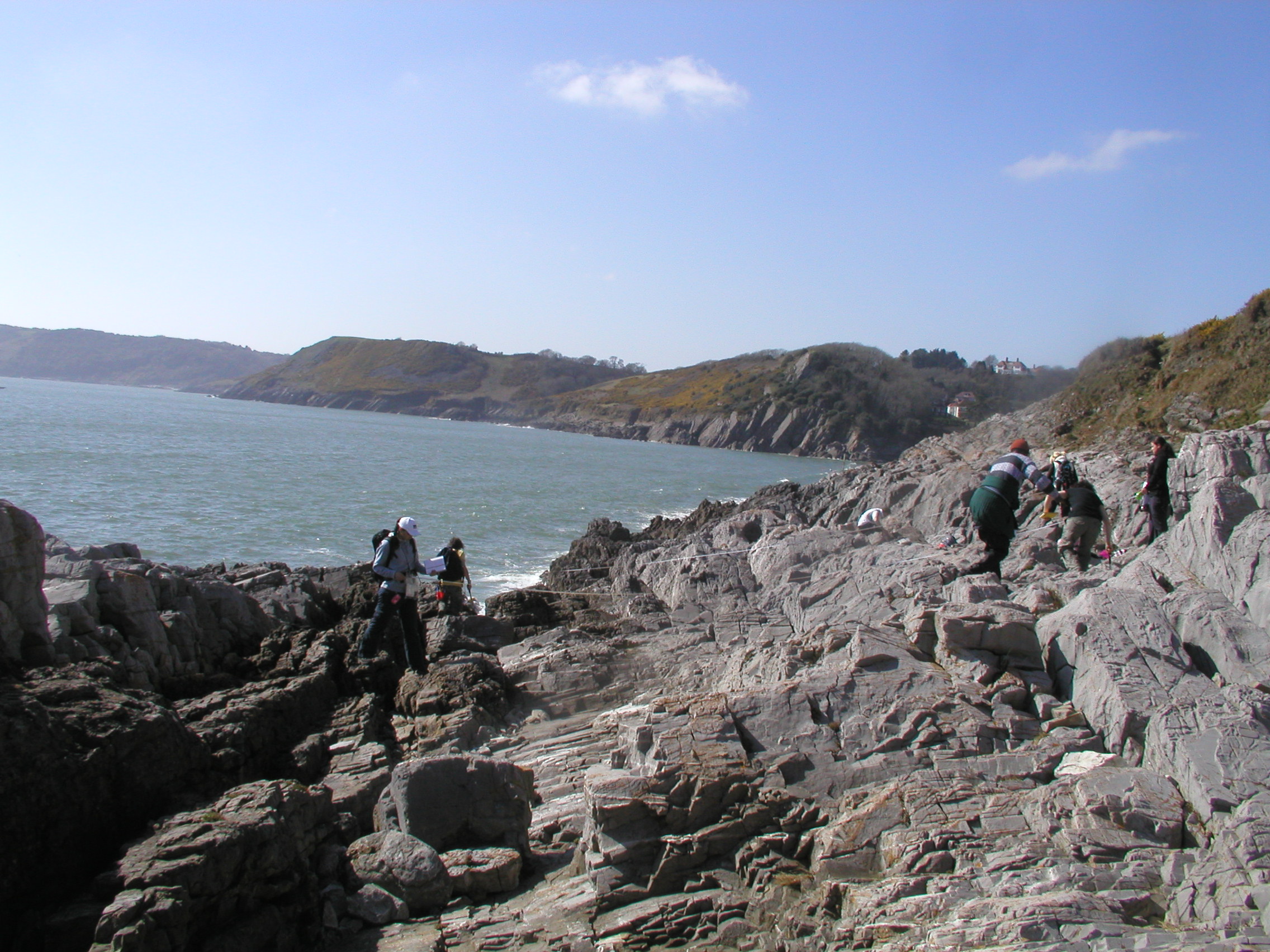
B. Part of the logged section. Strata young and dip steeply to the right
(north)
|
| |
|
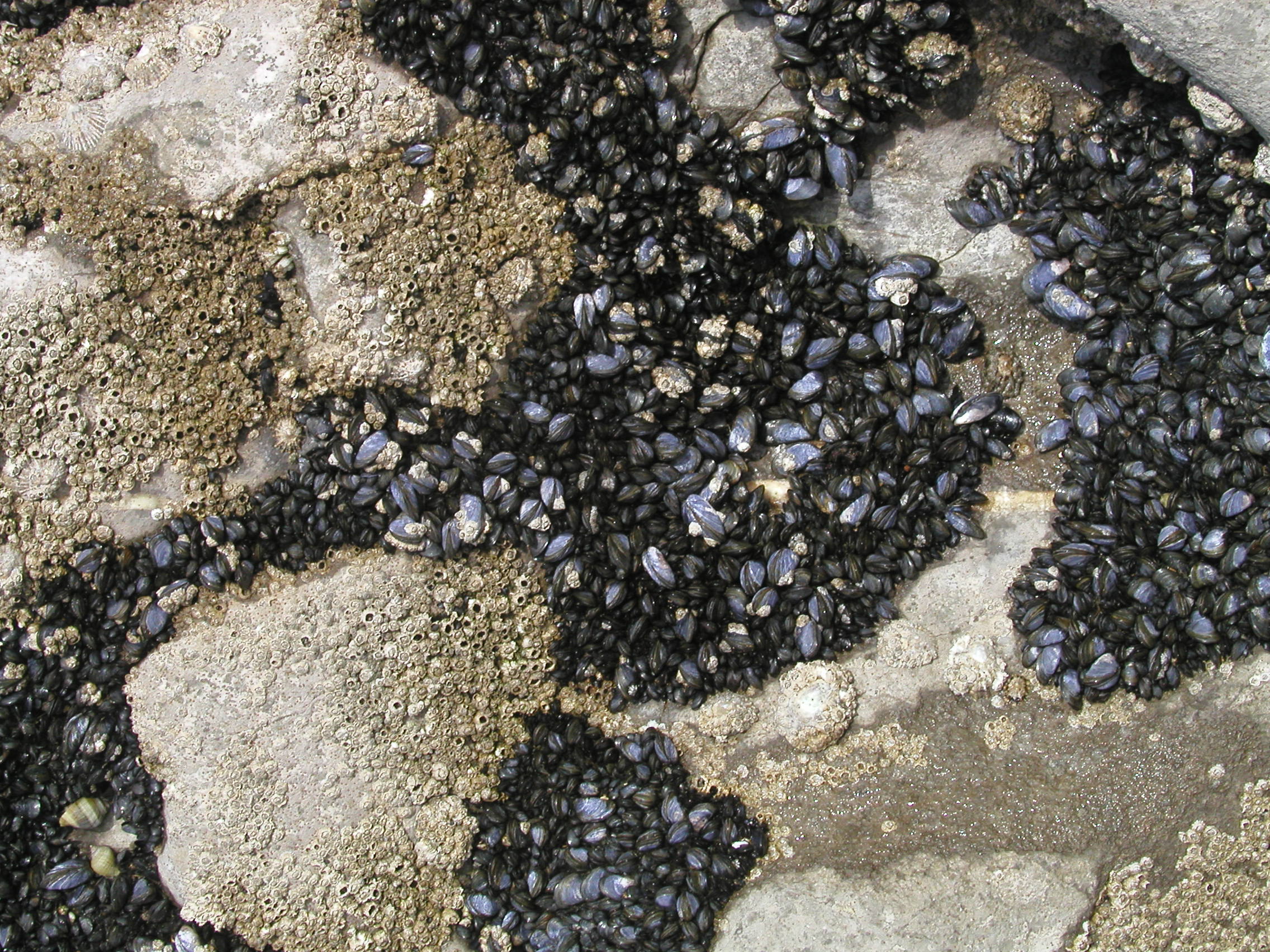
C. Our goal is to study ancient carbonates, but here are some modern carbonate-producing
organisms in the intertidal zone at this location
What are the organisms
shown? Try to classify them. Which of them are geologically important
as sediment formers?
|
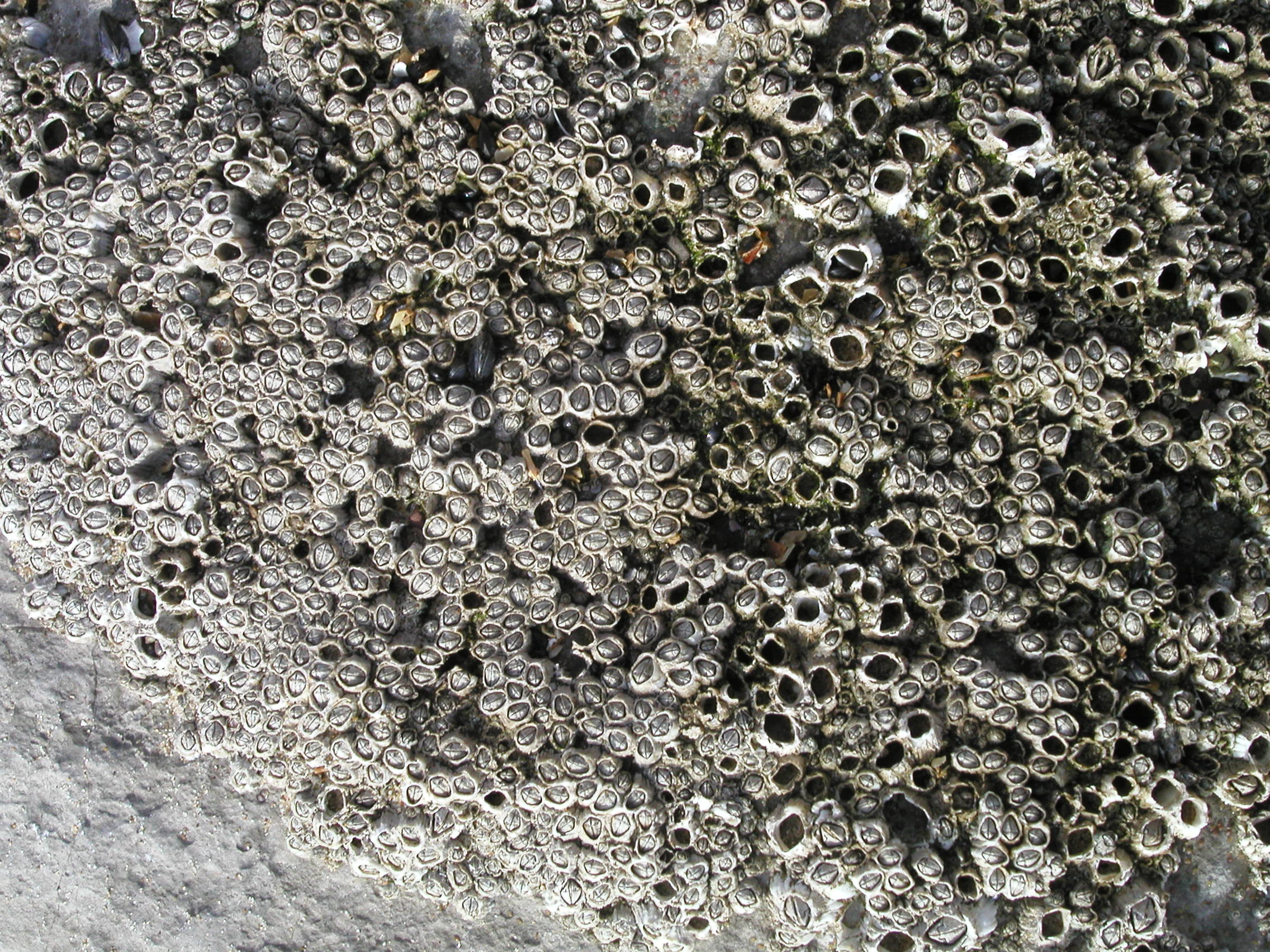
D. What are these organisms? What are their closest relatives? |
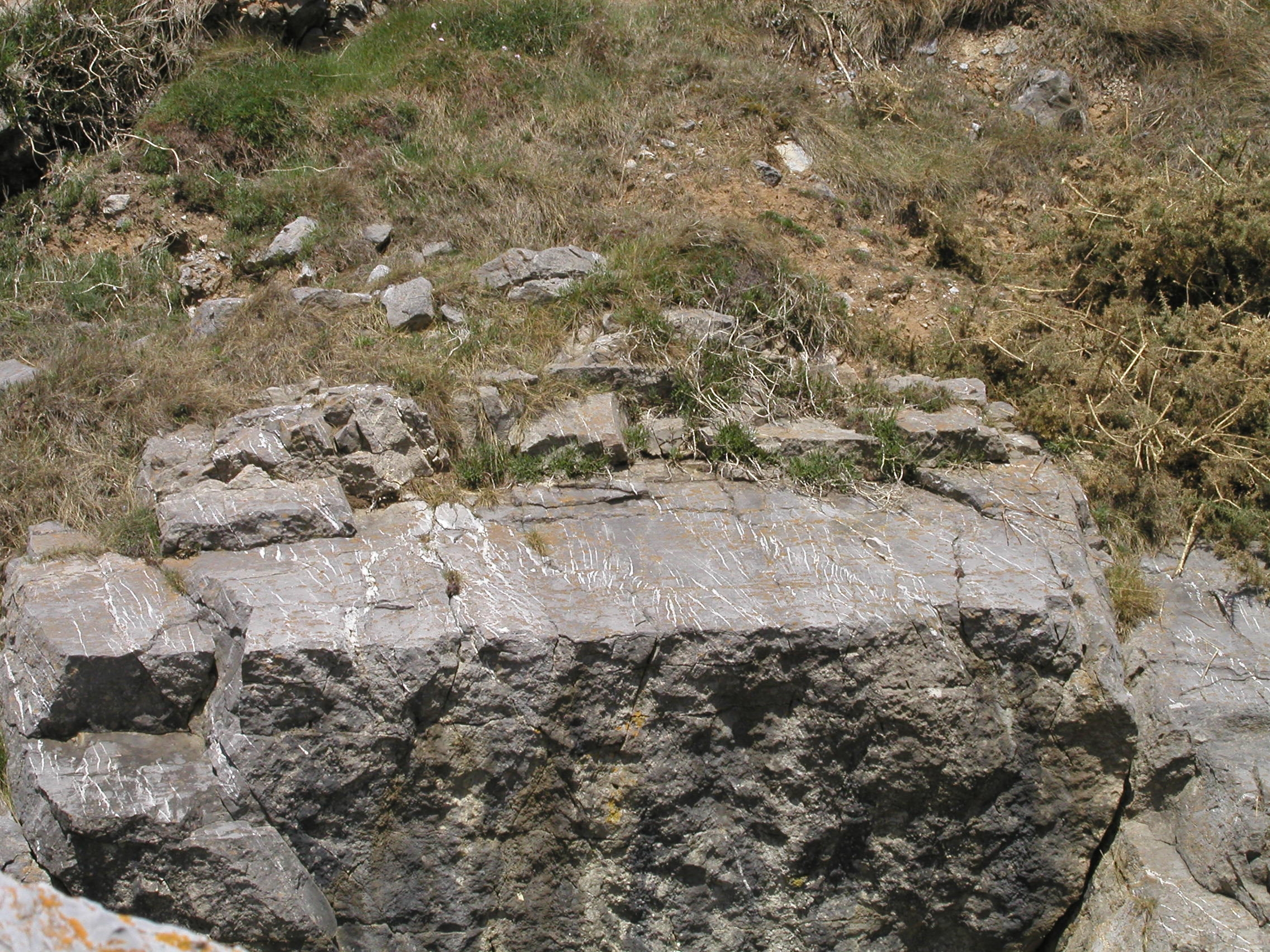
E. The rocks here show strong Variscan deformation, including folding and
thrusting. On a small scale, much of the deformation is brittle, as we would
expect in competent, rigid limestones. Here are some fine sets of tension
gashes. |
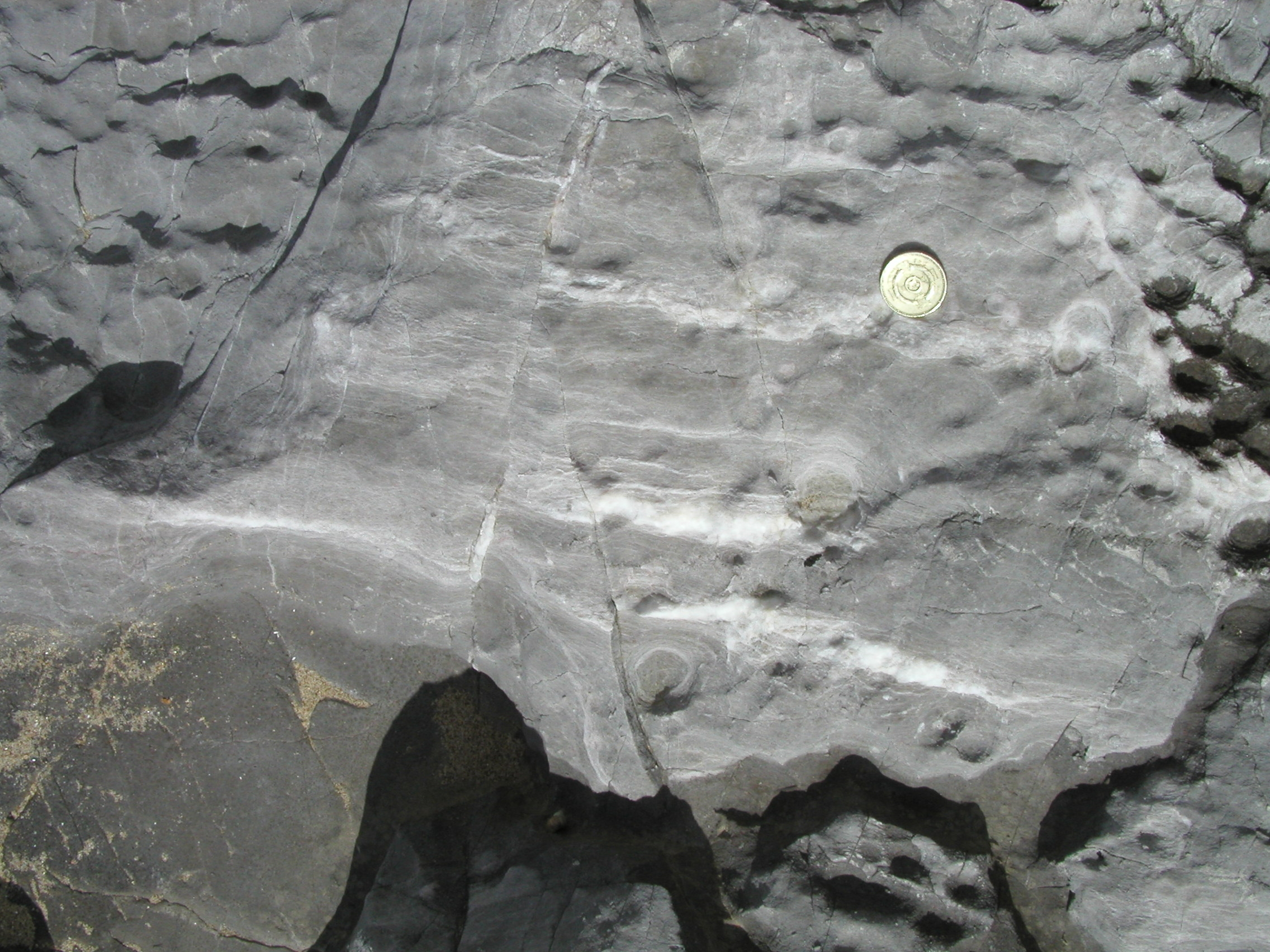
F. Minor faults and shear zones. |
There's a lot of interesting, detailed
geology here, especially for limestone fans, and we usually spend 3-4 hours
logging this section and admiring the view.
As always, the aim of this exercise
is to synthesize information of a variety of different types - for example lithology,
thickness and geometry of sedimentary units, sedimentary structures and palaeocurrents,
fossils and trace fossils (or absence thereof), lateral and vertical changes
etc. From these observations, presented on your log, you should be able to attempt
interpretations of the the processes, conditions and environments involved in
the formation of the various units.
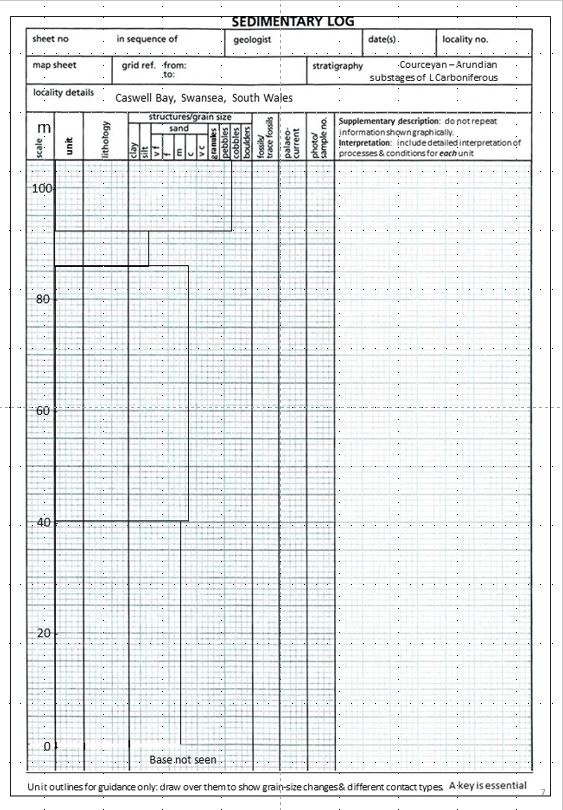 |
The Caswell Bay log.
A higher resolution version
is provided in the Base Maps file for you to complete your log.
|

Black Rock Limestone Subgroup (0
to 40m on log)
We last saw the Black Rock Limestone
(BRL) at the top of the section at Skrinkle Haven, above the Avon Group. The
upper part of it is exposed here, but we don't see the base in this section.

Caswell Bay Oolite Formation (also
known as Gully Oolite) (40 to 86m on log)
To study this formation in detail,
we are going to take two short, interactive virtual field trips. Each consists
of 6 images, from broad scale views down to microscope views. Proceed through
the field trip using the arrows. The  icon will load a higher magnification view of the image; the
icon will load a higher magnification view of the image; the  icon will take you back to the home page. Study the images and answer the interactive
questions. Make notes and images in your virtual notebook as you go through
the trips.
icon will take you back to the home page. Study the images and answer the interactive
questions. Make notes and images in your virtual notebook as you go through
the trips.
Additional images and information
from the Caswell Bay Oolite (CBO):
|
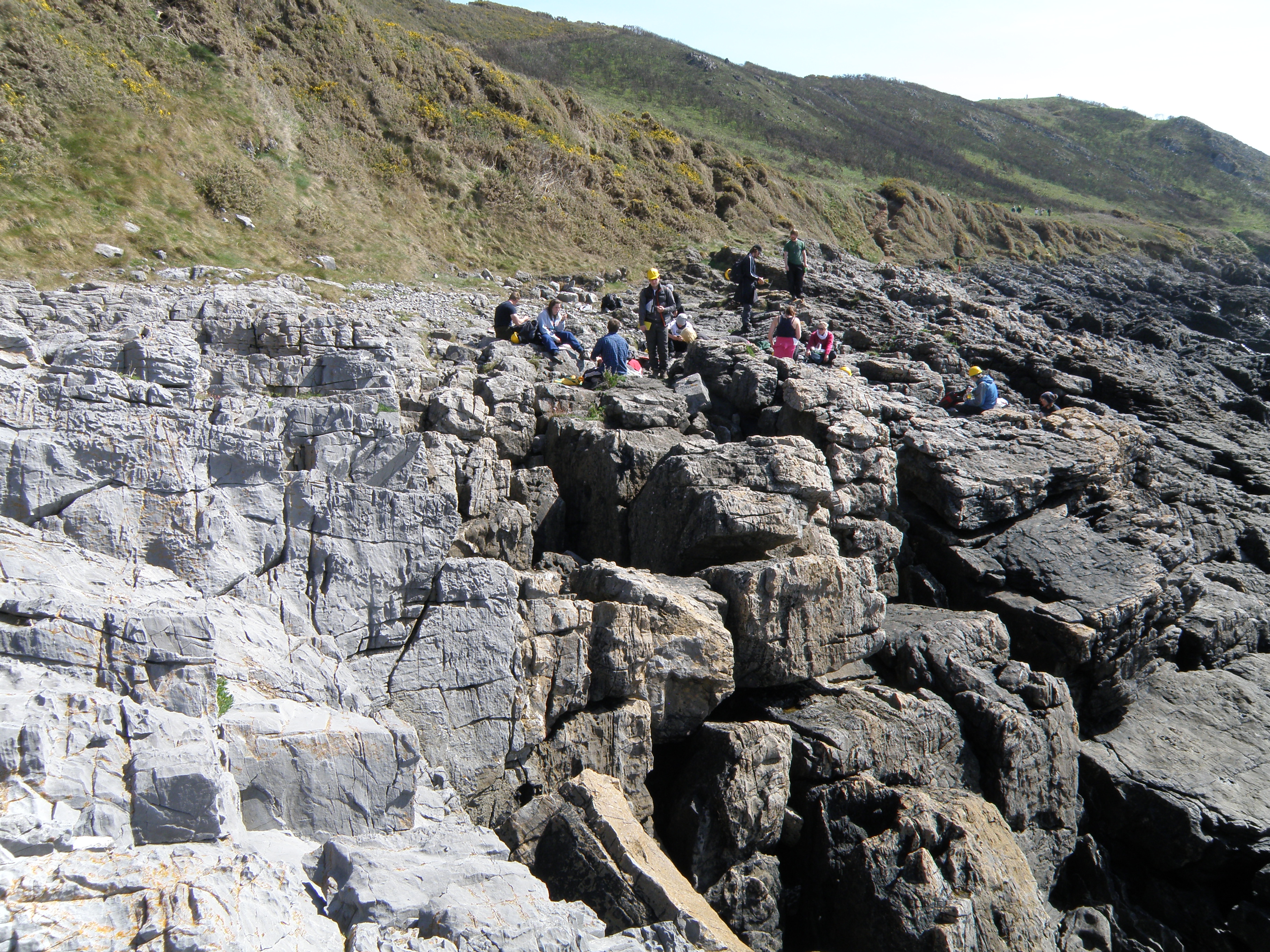
H1. View along the sharp, roughly planar contact between the dark BRL
(right) and the lighter CBO (left). Beds are vertical and young to the
left (north)
|
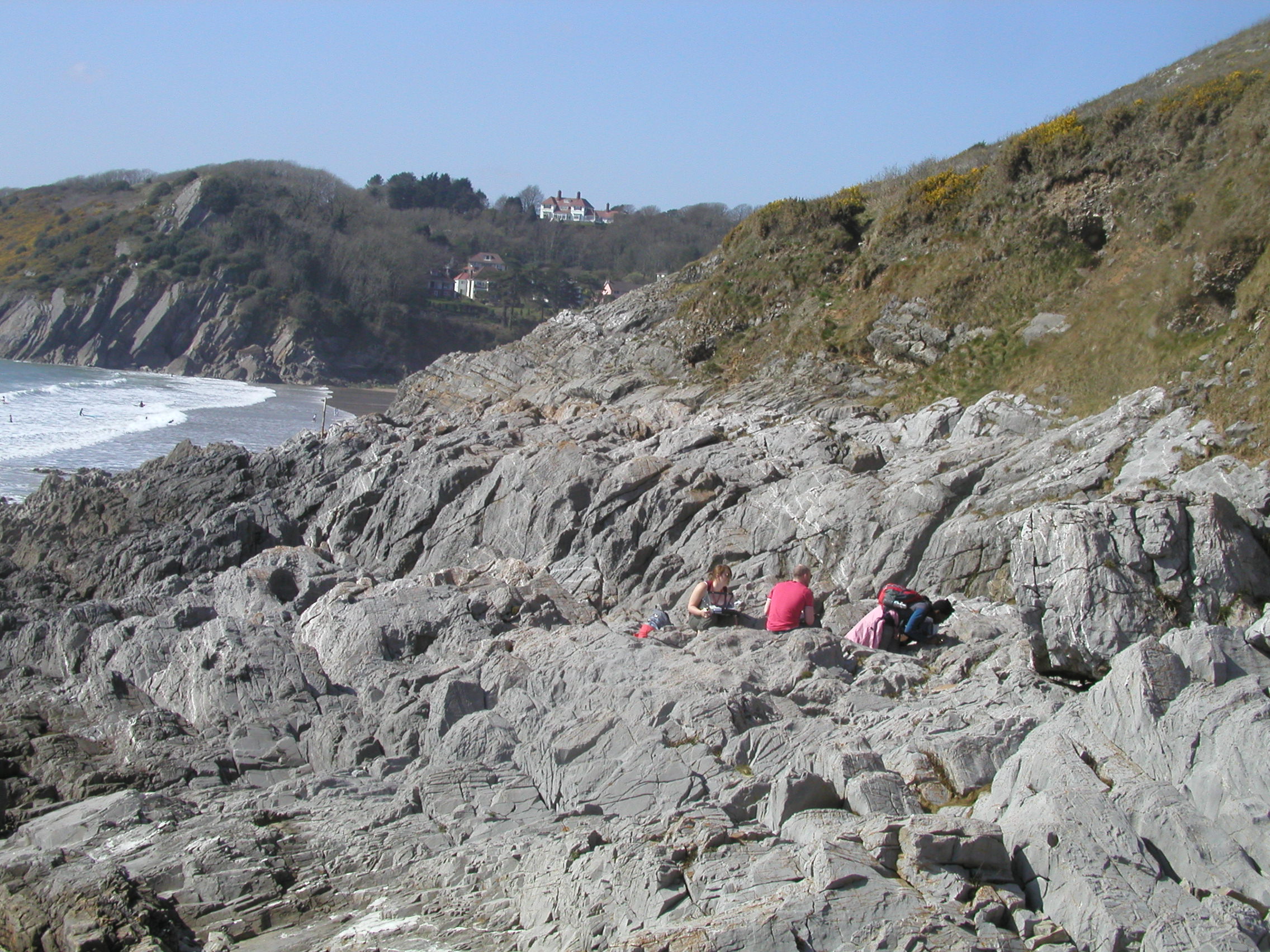
H2. CBO dips steeply north (right). Note the distinctive light grey colour
of the CBO.
|
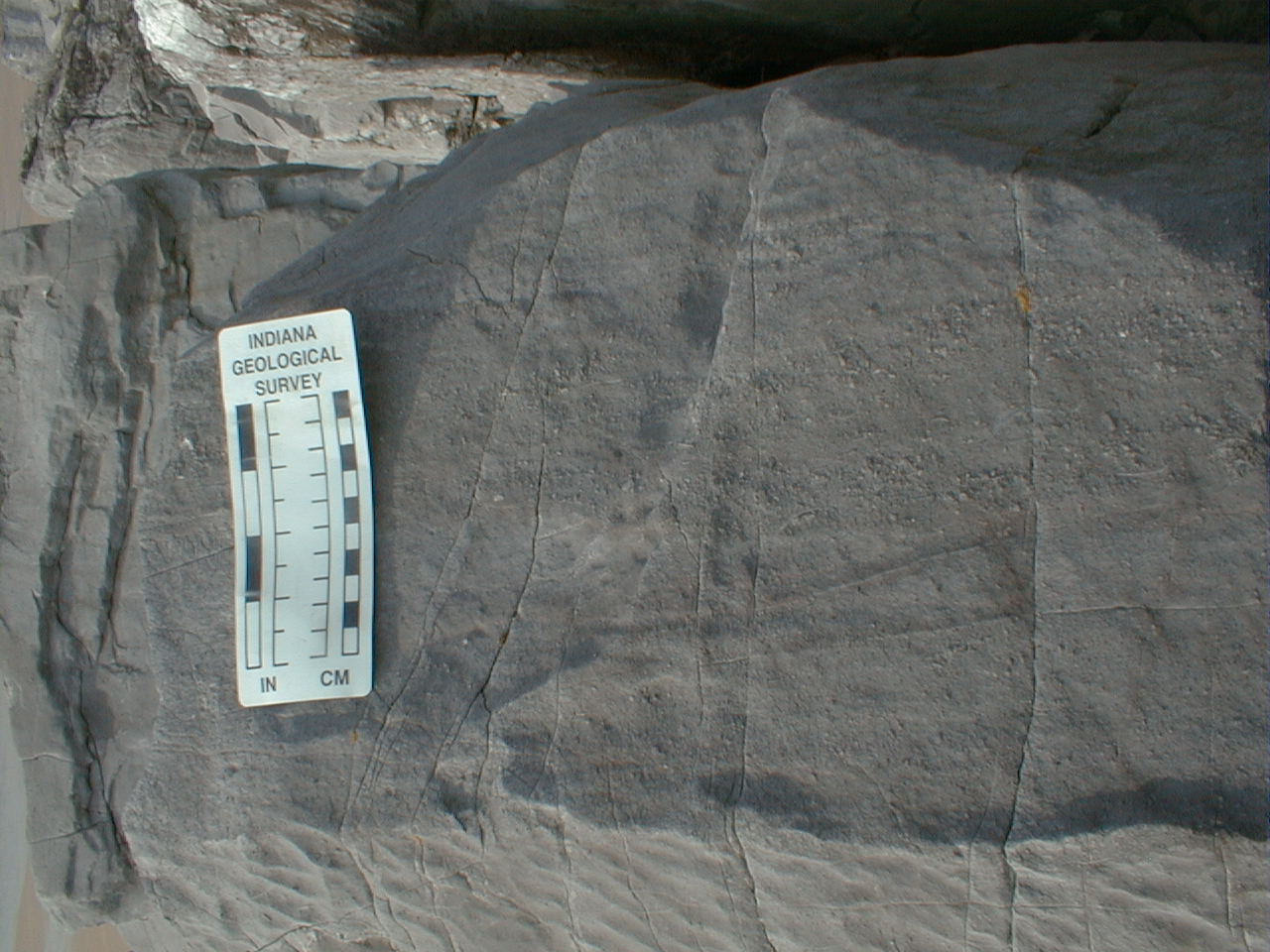
H3. Bedded CBO. What are the coarser components likely to be? |
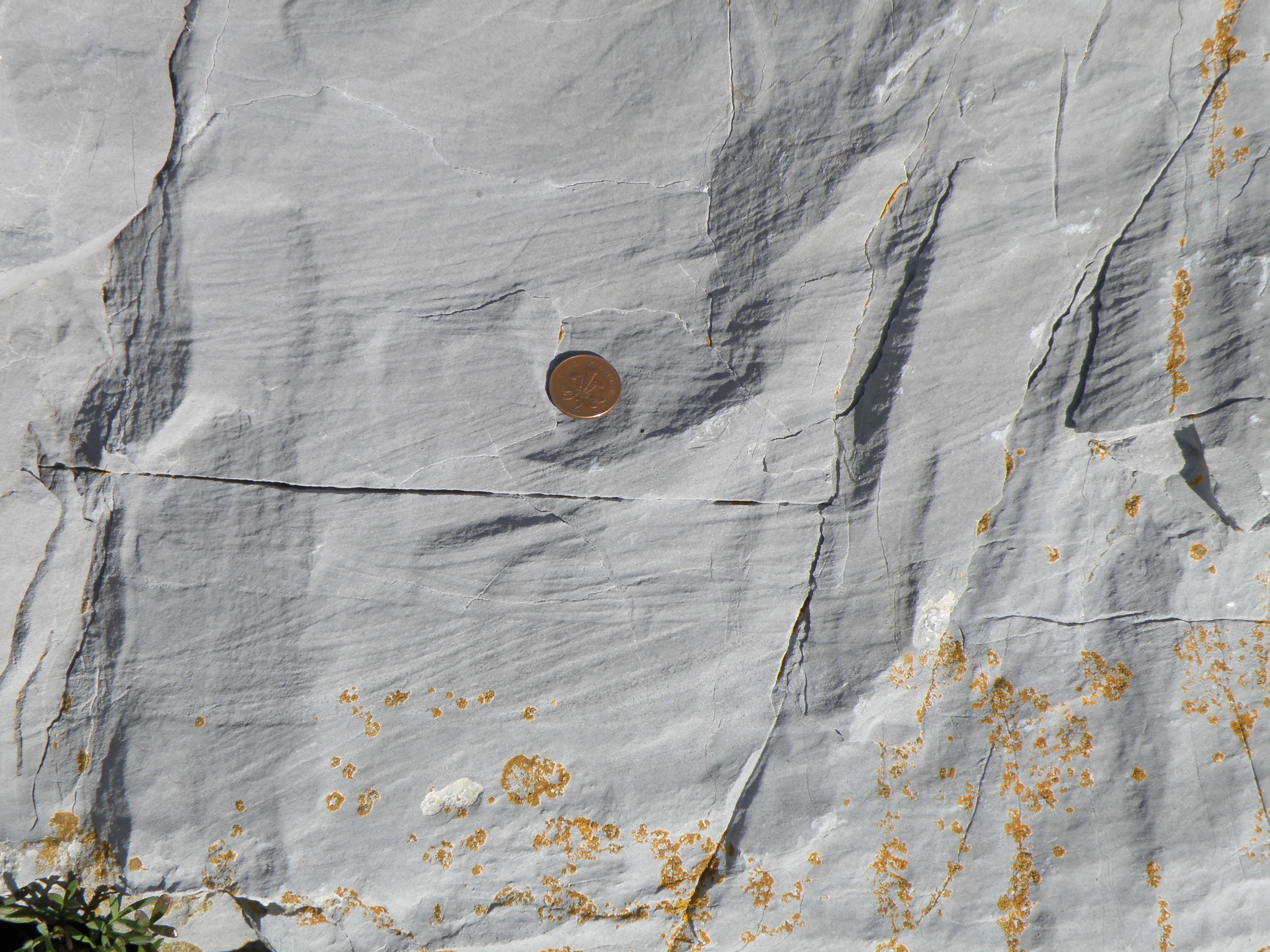
H4. Identify these structures. What do they tell us about sediment transport? |
|
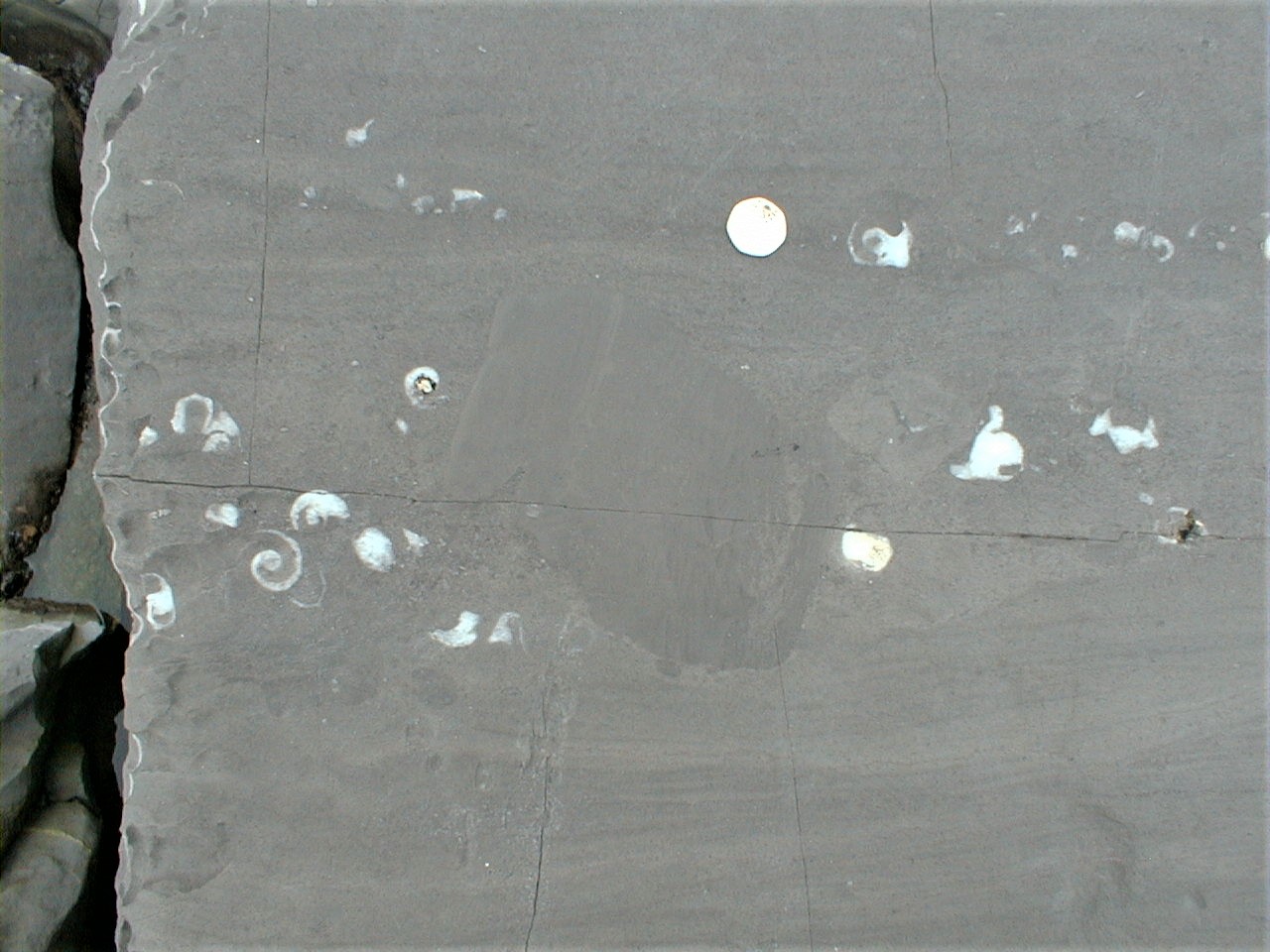
H5. This is a section through the basal contact of one of the coarser
beds seen within the CBO.
Describe the contact.
Identify the components of the coarse bed. What structures are present
in the bedded oolite below?
|
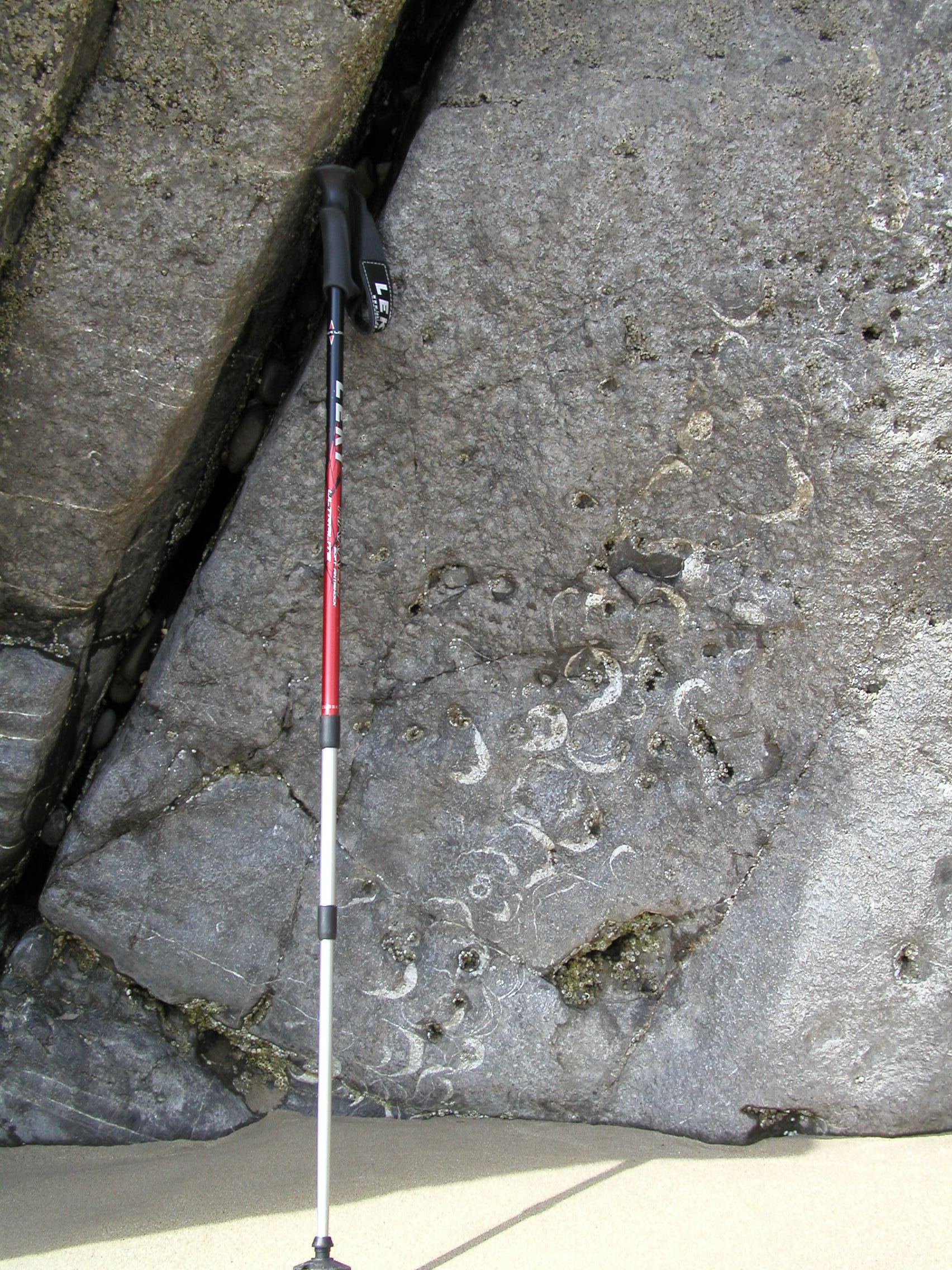
H6. Another coarse bed within the CBO.
What is the main
fossil component?
|
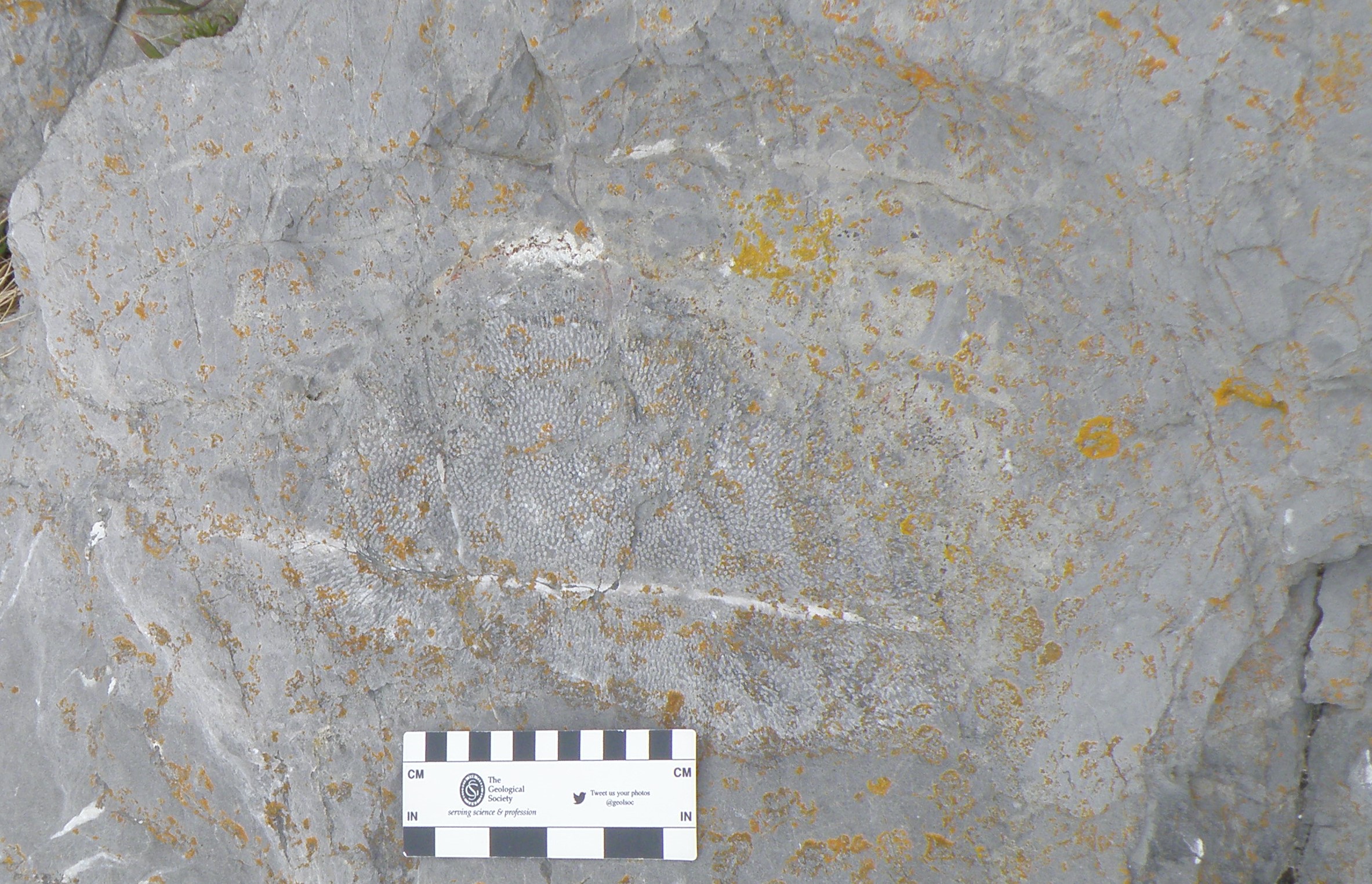
H7. Large clast in one of the coarser beds.
Identify it as accurately
as possible, and comment on the sedimentary processes involved.
|
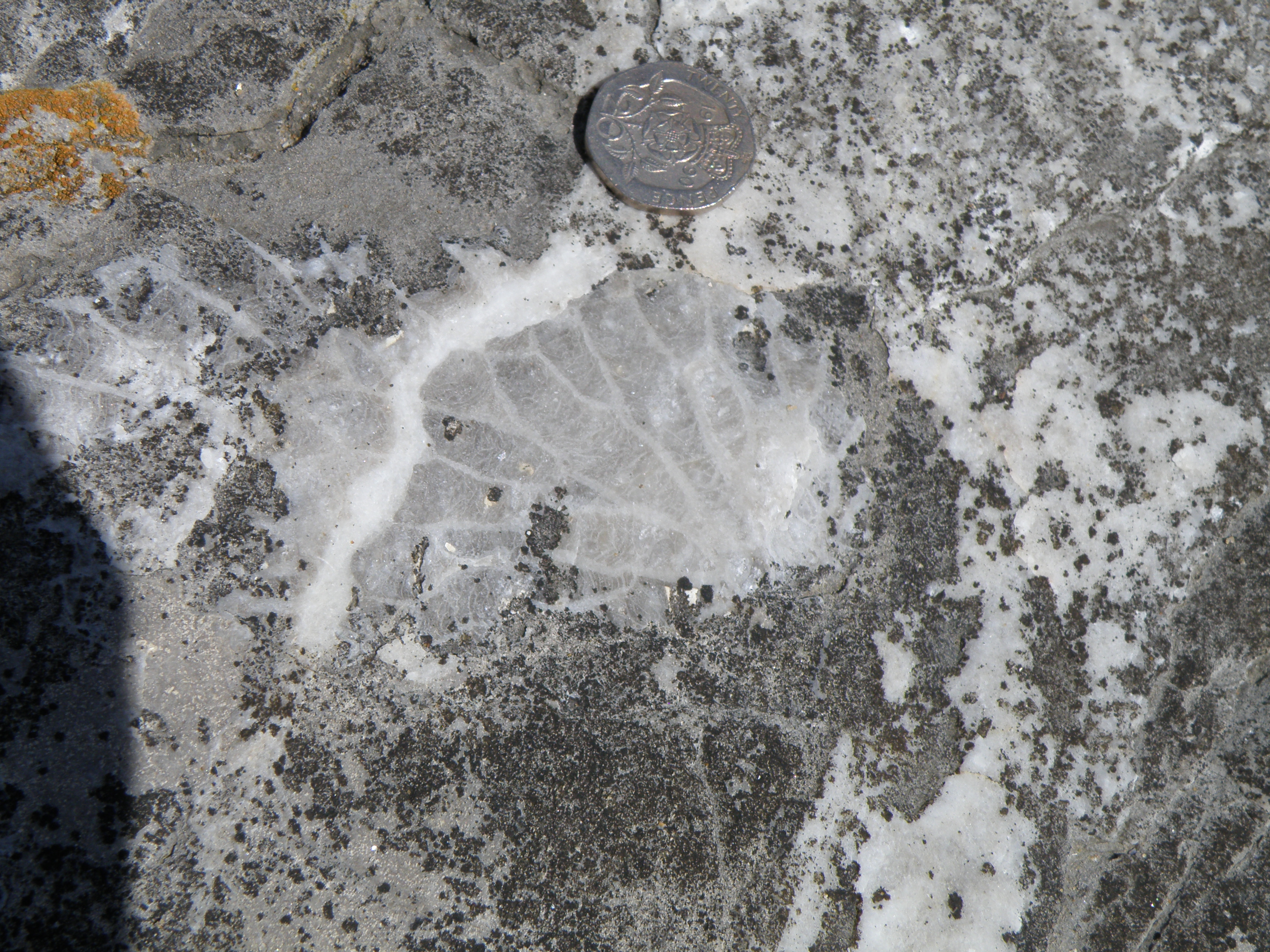
H8. Another large clast in one of the coarser beds.
Identify it as accurately
as possible, and comment on the sedimentary processes involved.
|

Caswell Bay Mudstone Formation (86
to 92m on log)
This unit is quite different from
any other limestones in this section. Some of the beds do not react with acid,
suggesting they are dolomitized. Macrofossils are largely absent from these
beds, unlike other units in the logged section. What might this tell us about
environmental conditions?
|
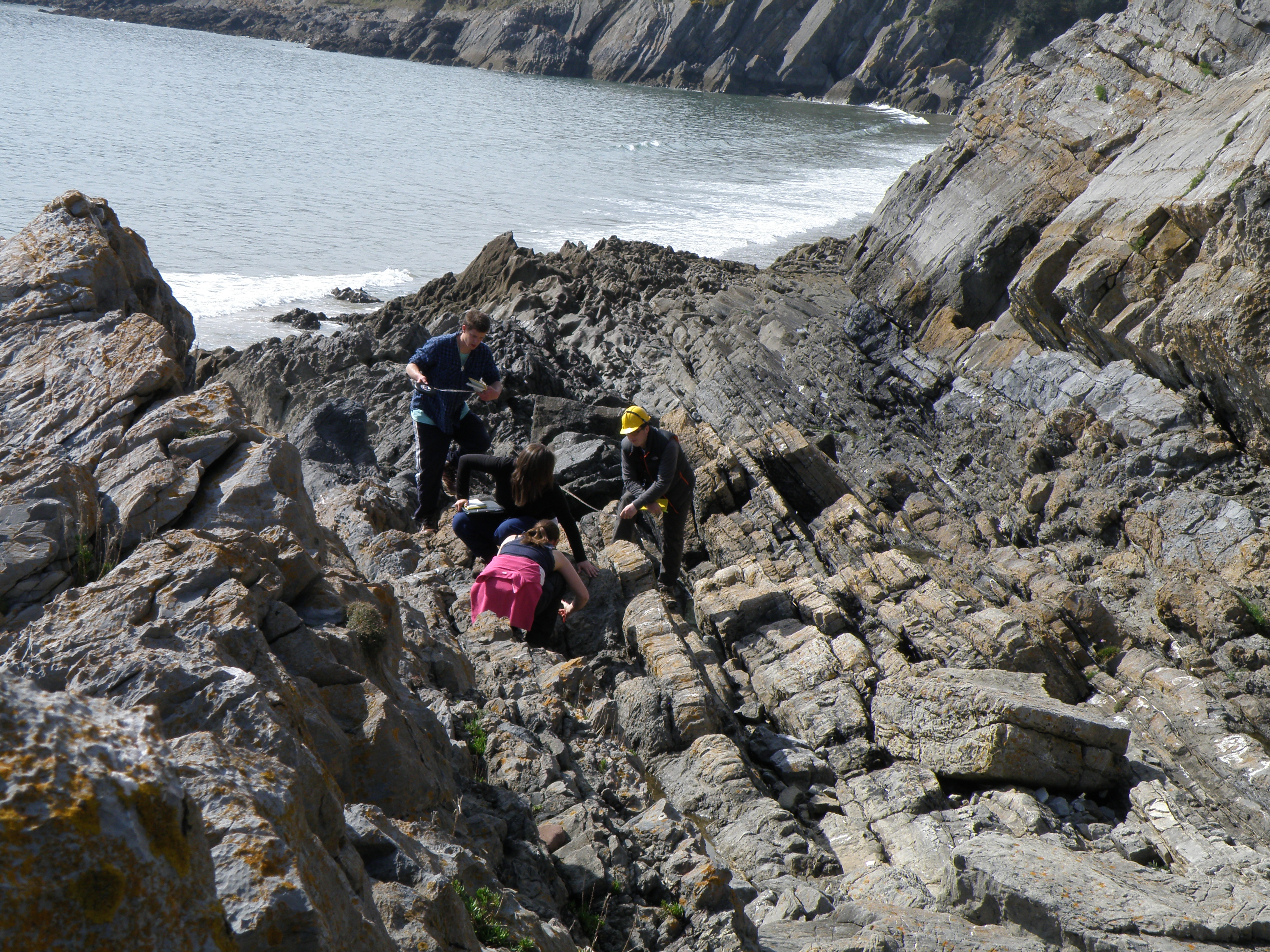
J1. Beds dip steeply right (north). The feature on the left is the highly
irregular dip slope at the top of the CBO. The contact with the overlying
Caswell Bay Mudstone Formation (CBM) is 1m to the left of the geologist
with the pink sweater.
|
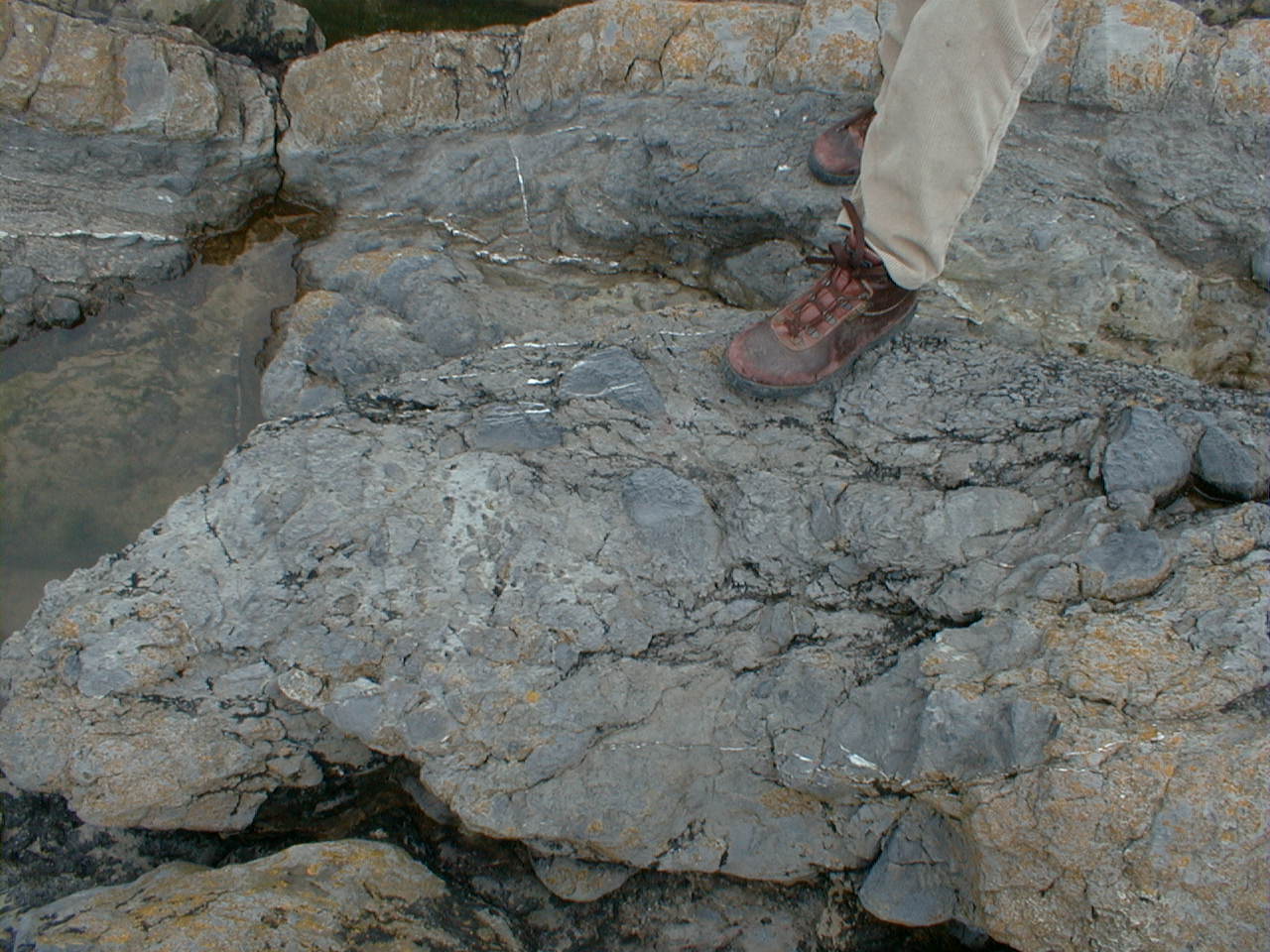
J2. The discontinuous basal unit of the CBM - this rock infills hollows
in the irregular top of the underlying CBO. Above this coarse rock, laminated
limestones are seen at the top of the photo. |
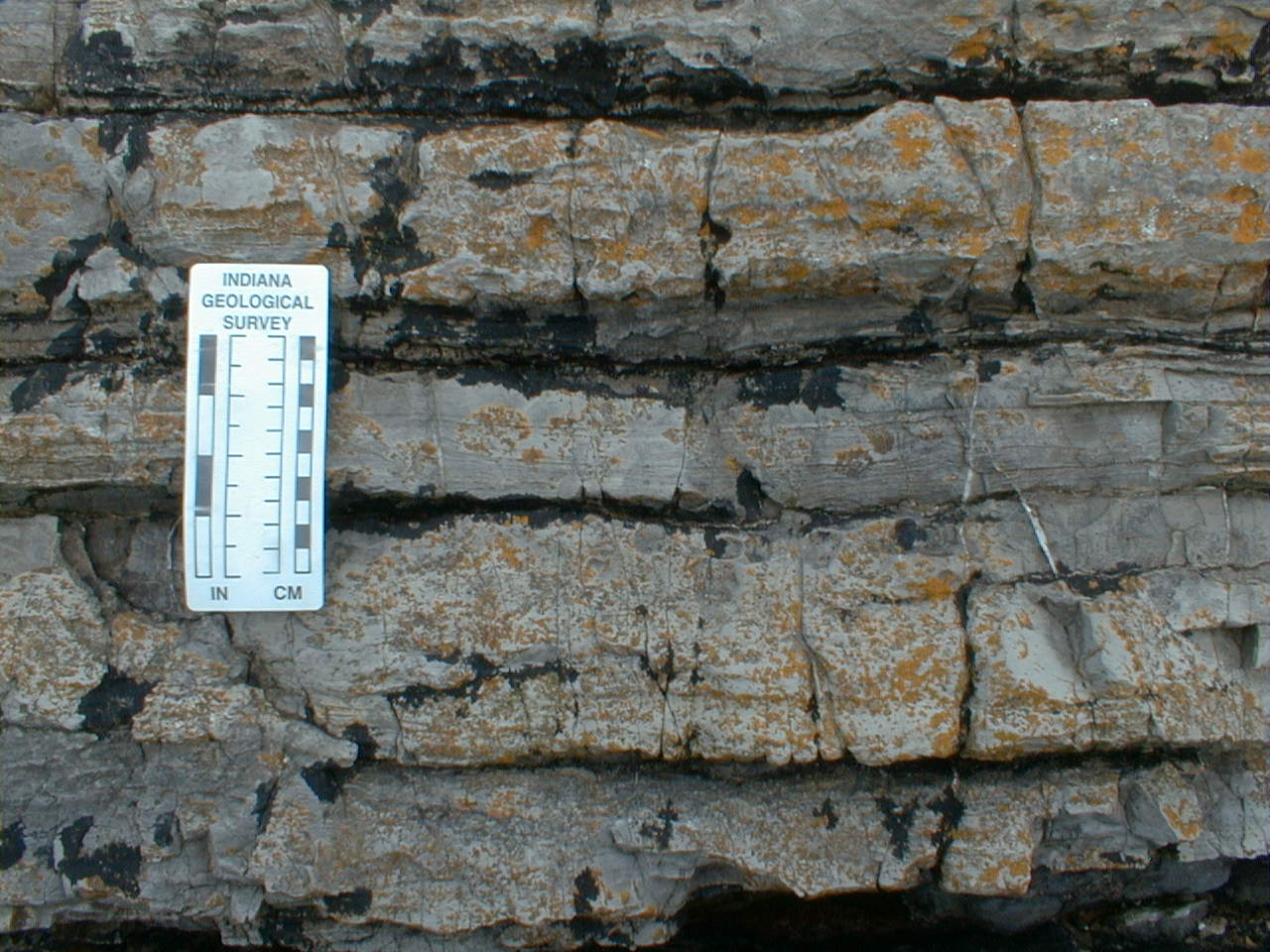
J3. Laminated micritic limestones of the CBM. |
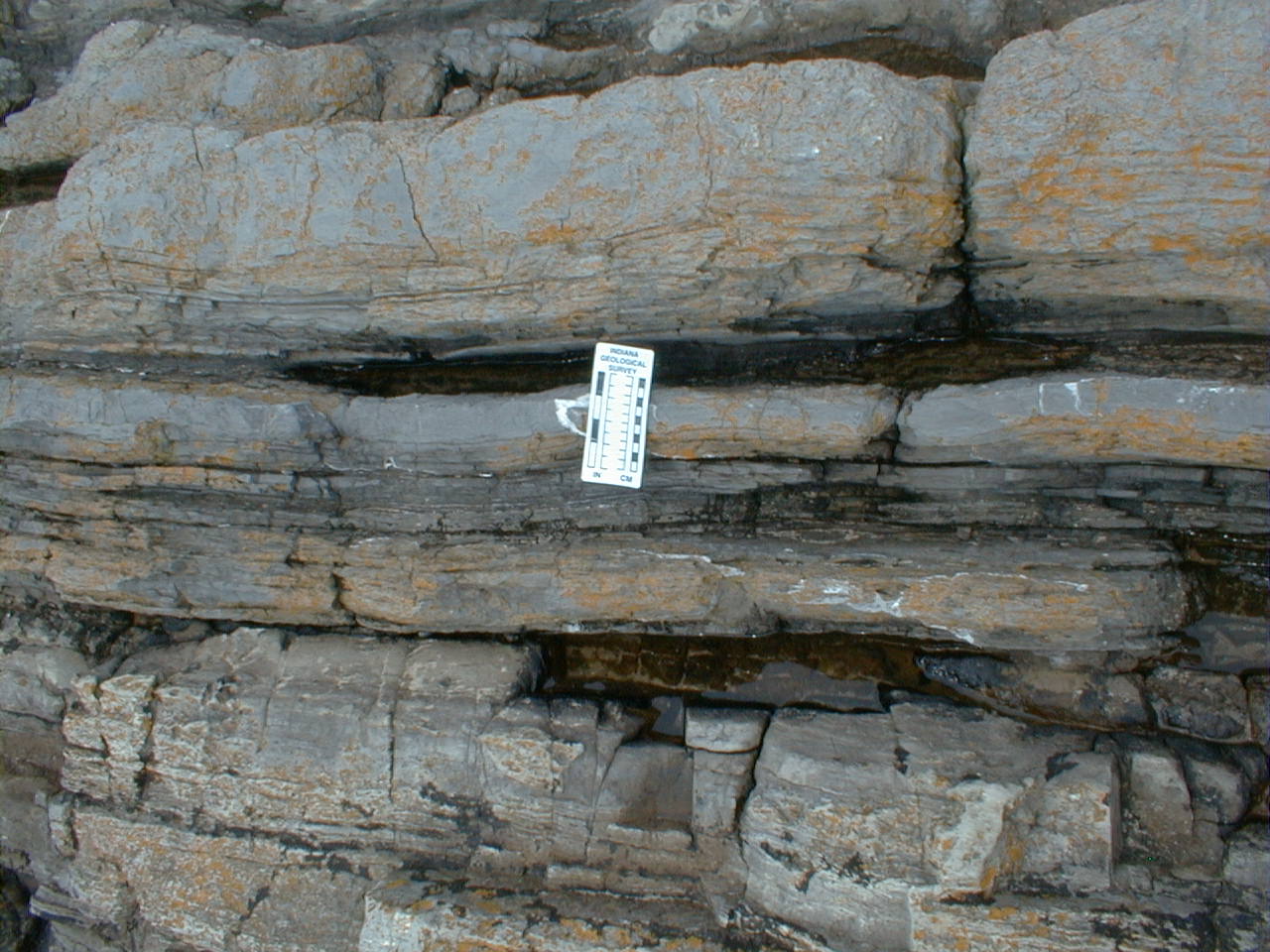
J4. There are interbeds of mudstone, weathering back, within these laminated
micritic limestones.
Look carefully at
the laminations in this photo and J3.
|
|
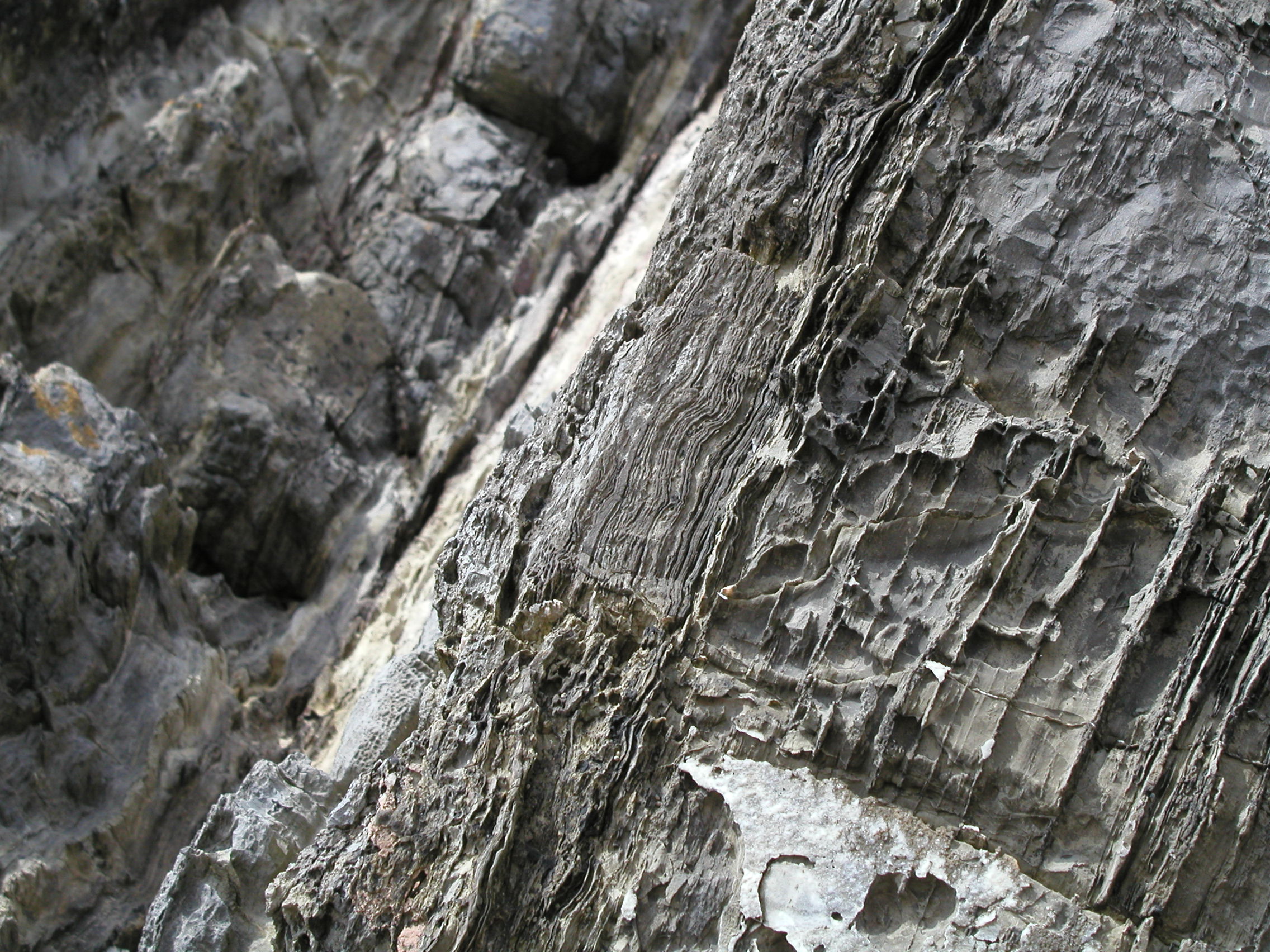
J5. Steep dip and younging to the left.
Try to account for
the nature and origin of the laminations in this micritic limestone.
|
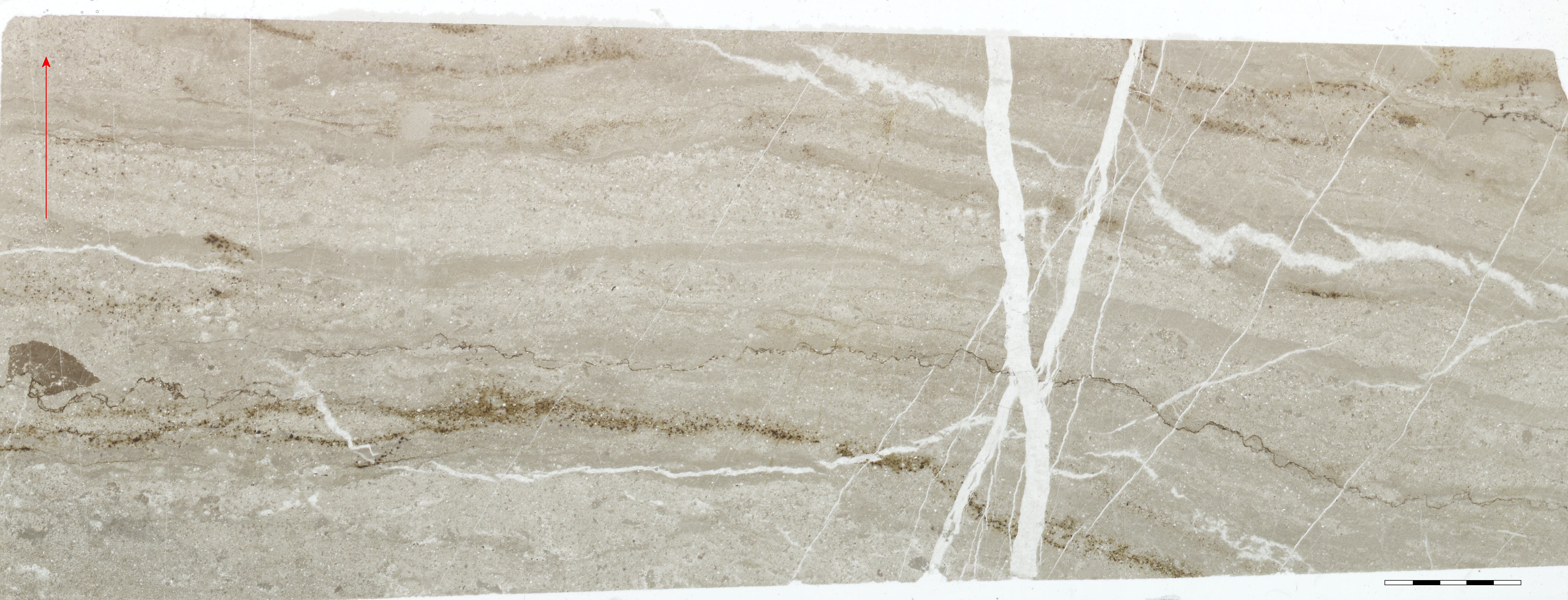
J6. Thin section of a laminated limestone bed in plane-polarized light
(PPL). Scale in mm. Arrow shows way up.
Describe the depositional
and diagenetic features you can see.
|
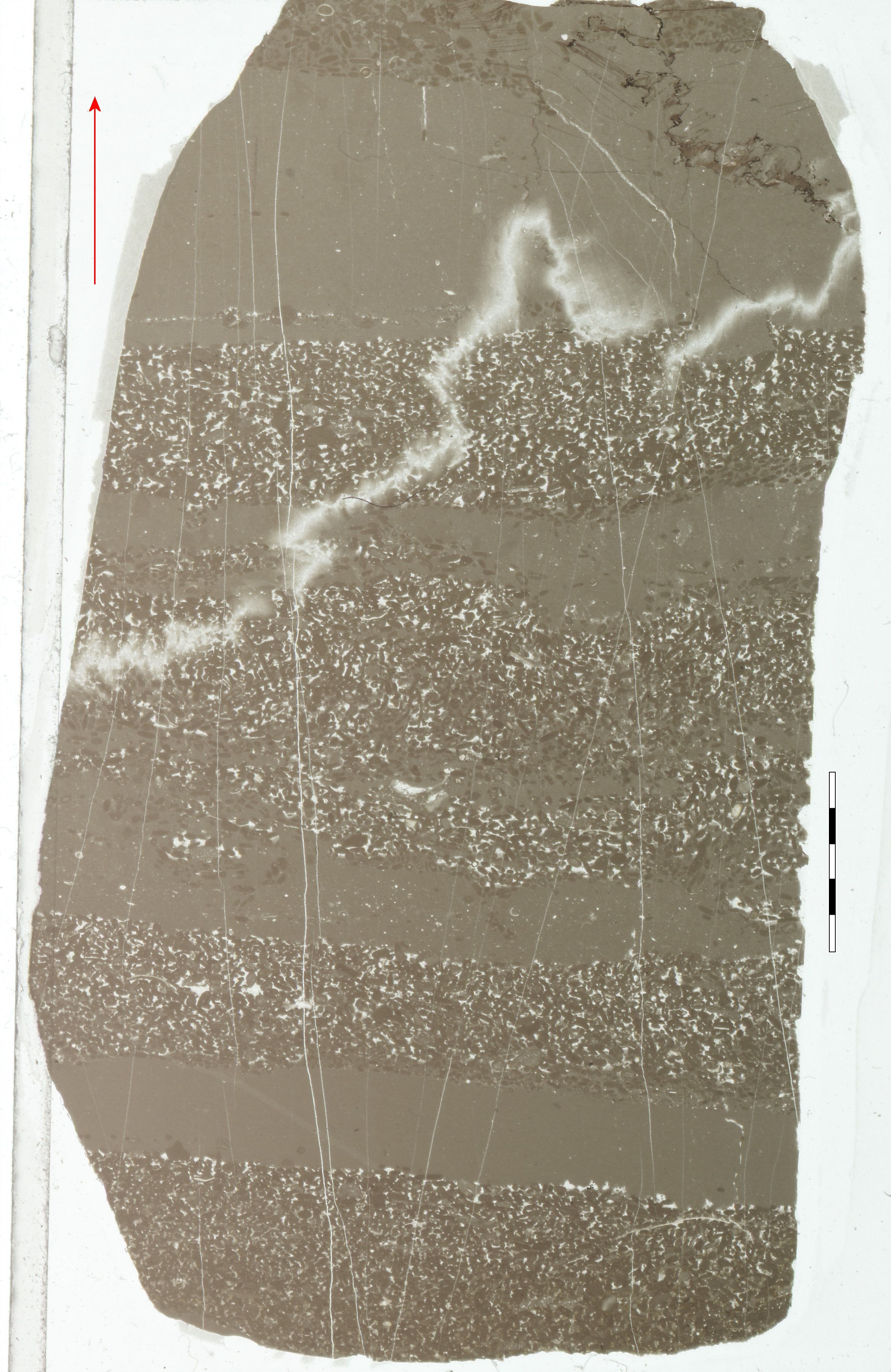
J7. PPL; scale in mm; arrow shows way up.
Describe the two
lithologies. What are the grains in the coarser laminae?
|
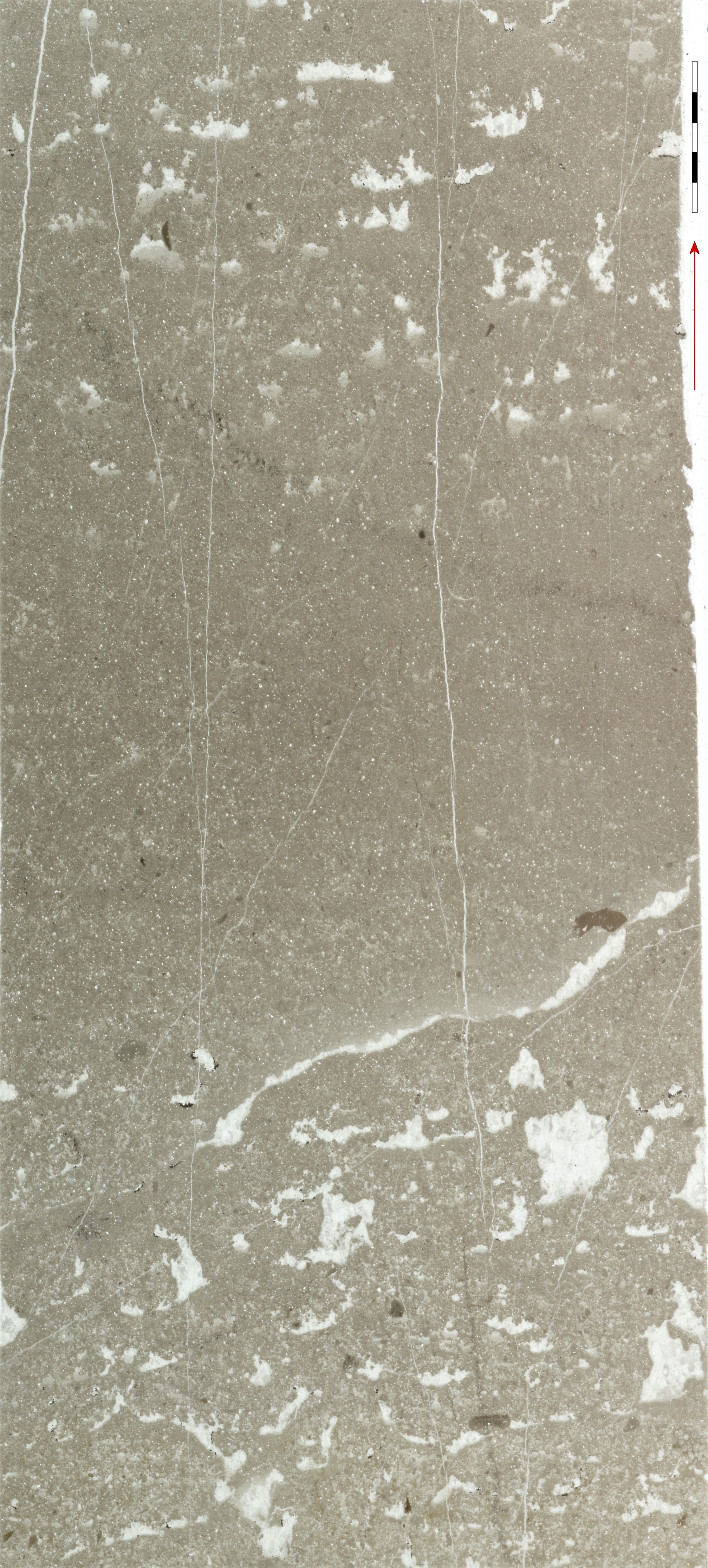
J8. PPL; scale in mm; arrow shows way up.
What are the light-coloured
features in this micritic limestone? How and when did they form?
|

High Tor Limestone Formation (above
92m on log)
In this rather coarse-grained unit,
macrofossils again become abundant. All beds react reasily with dilute HCl.
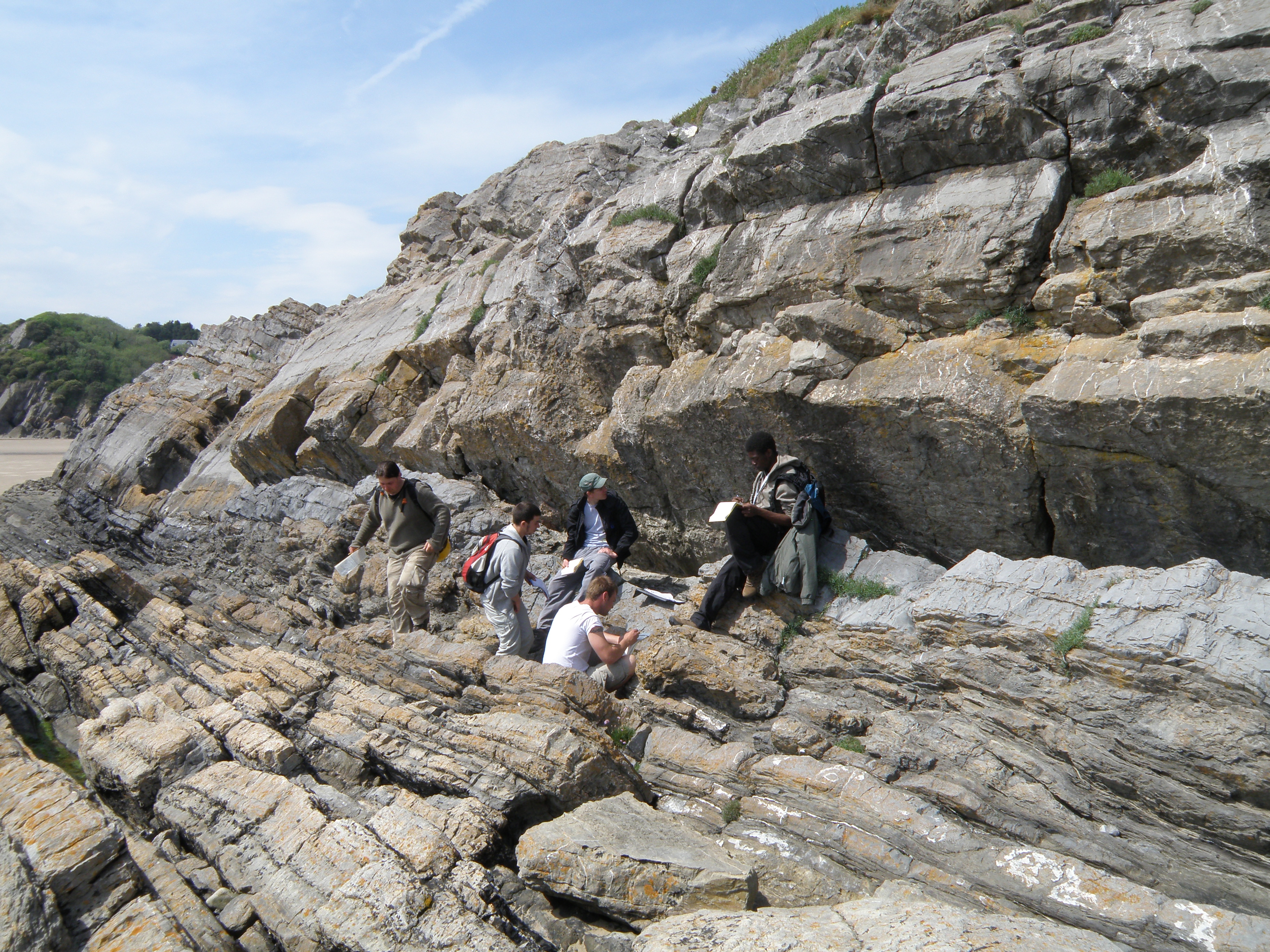
K1. View of the Caswell Bay Mudstone Formation and its sharp, more or less
planar contact with the overlying High Tor Limestone (HTL). The contact
is in the narrow gap under the overhang. The dip is now less steep, still
to the north. |
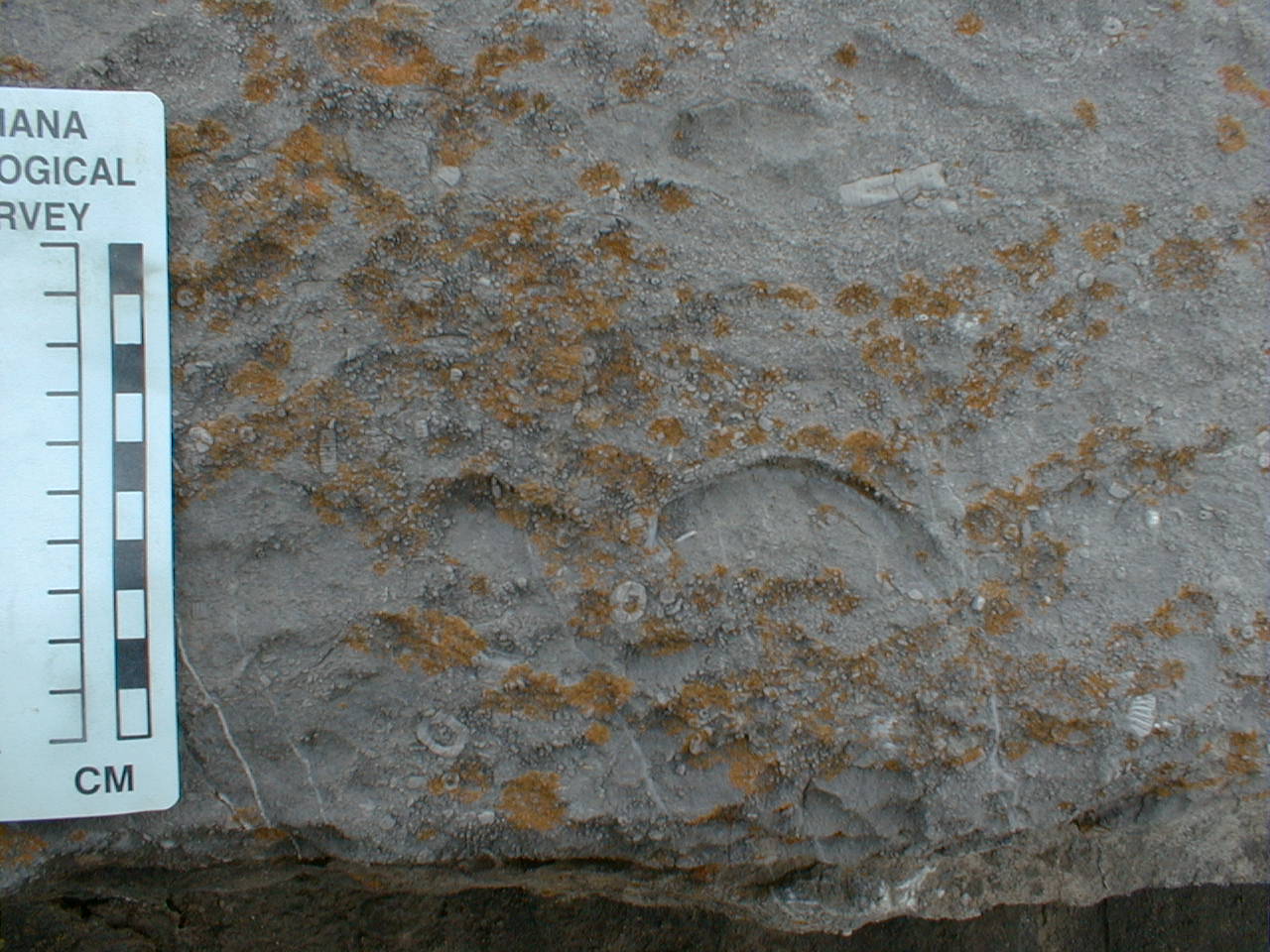
K2. A closer view of the HTL, 50 cm above its base.
Give as full a description
as possible, using the hand specimen scheme. Identify the fossils present.
|
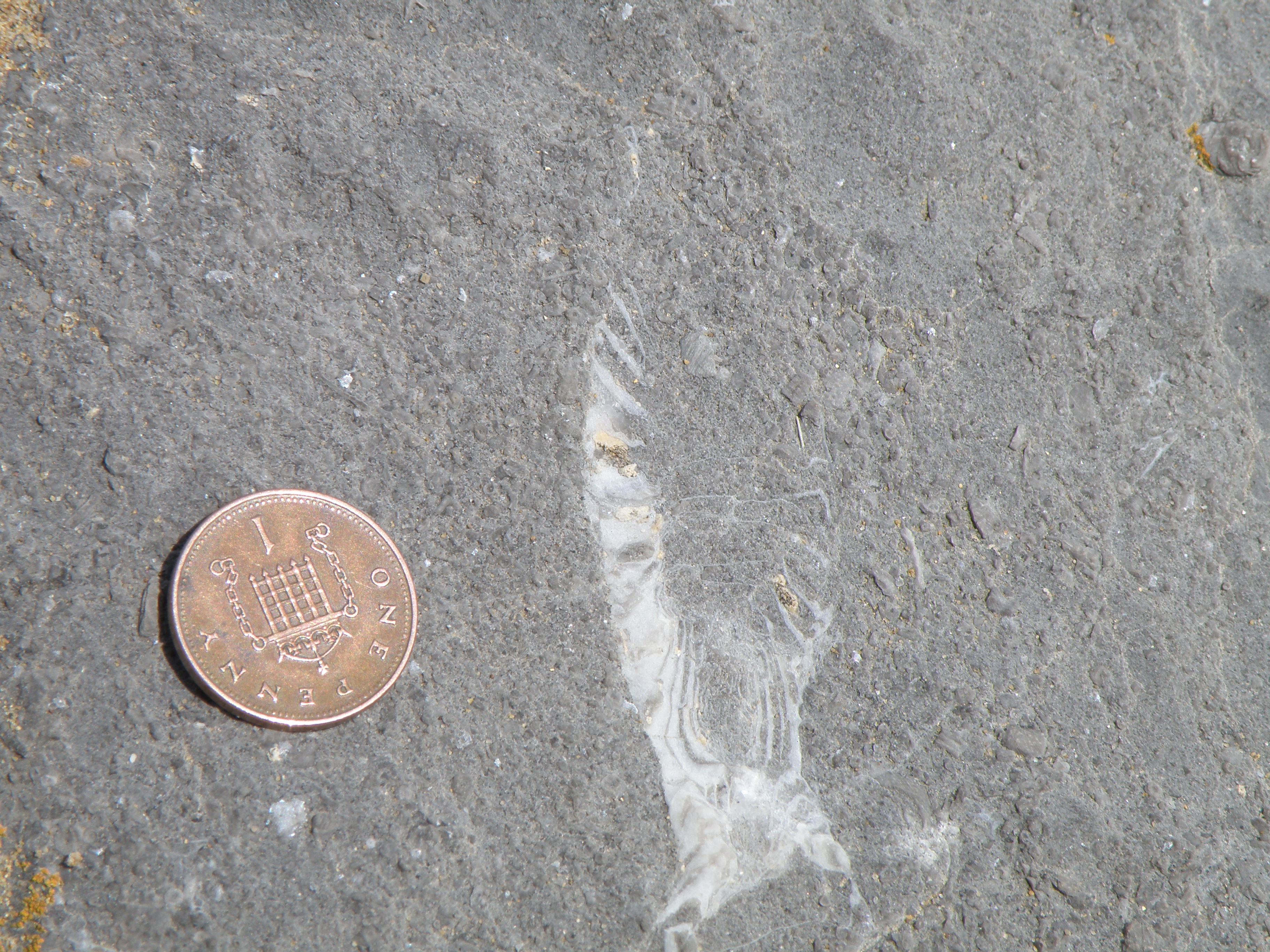
K3. Comment on the grain size, sorting and fossil content of this limestone,
in the bed above K2. |
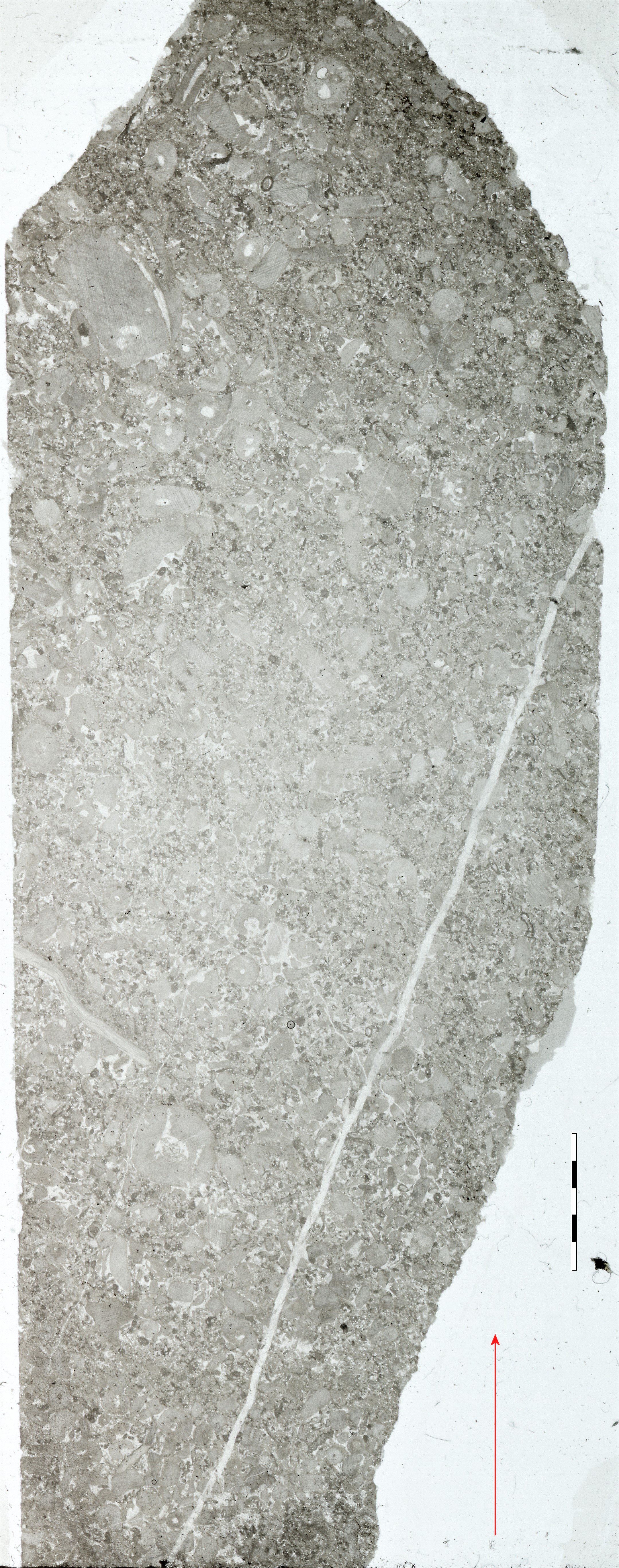
K4. Thin section of the rock shown in K3. PPL; scale in mm; arrow shows
way up.
What additional information
can you obtain from this view?
|

Interpreting the field evidence
You have now acquired a variety of
different types of data on the sedimentary sequence shown in the log. This includes
lithology, sedimentary structures, fossils and field relationships seen in photographs
and samples. Once you have completed your log, your task is to interpret the
data.
- For each major unit or significant
surface on the log, write a brief interpretation of the processes and conditions
of formation. Include in your interpretation information such as environmental
energy, flow regimes, salinity, oxygen levels, depth etc. There must be evidence
to support all of your interpretations.
- Suggest a depositional environment
for each unit.
- Write a short interpretative account
of changes in processes, conditions and environments from the base to the
top of the logged sequence.

Just for fun...
I recently discovered the Welsh composer
Grace Williams on the radio. She was born in Barry, our next location. Listen
to some of her music and see what you think - perhaps start with Hiraeth.
If you like this, check out her
YouTube channel.
Since we're in Glamorgan, today's
recipe is for
Glamorgan sausages - possibly the world's first vegetarian sausages, made
with cheese and leeks. This recipe is from the Hairy Bikers.

Next locality
Make sure you've completed all the
work for this locality. Now we can get back on the virtual coach and head off
to our next stop at Barry Island

This page is maintained
by Roger Suthren. Last updated
13 January, 2021 12:08 PM
. All images © Roger Suthren unless otherwise stated. Images may be re-used
for non-commercial purposes.

![]()
![]()
![]() icon will load a higher magnification view of the image; the
icon will load a higher magnification view of the image; the ![]() icon will take you back to the home page. Study the images and answer the interactive
questions. Make notes and images in your virtual notebook as you go through
the trips.
icon will take you back to the home page. Study the images and answer the interactive
questions. Make notes and images in your virtual notebook as you go through
the trips.![]()
![]()
![]()
![]()